Page content - Navigation bar - Next
page - Previous page - Index ABC (EN)
- Intro-EN
- NL ![]()

Intro-EN

Megaliths: Appearance
Megalithic monuments of different models and age are existing in Western
Europe, North-Africa, the Middle-East,
India, Japan en America (N&Z).
The meaning and the age of megalithic constructions still is a controversial
subject.
Megalith = 'big stone' (Greek).
Standing stones
Standing stones, also called "menhirs", are up-standing stones witch
are mostly slightly shaped by human.
"Menhir" is formed by the Breton words 'men' (stone) and 'hir' (long).
Many standing stones are solitaire monuments, but they also exist in rows (alignment) like in Carnac and Kerzhero (Bretagne, France).


Alignments Kermario, Carnac
Some standing stones are colossal.
"Le Menhir du Champ Dolent" (Bretagne, France) is 9,6 meter high whit
a weight over 150
ton.
The big broken standing stone in Locmariaquer (Bretagne, France) had a length of
20-meter and a weight of +- 300 ton!
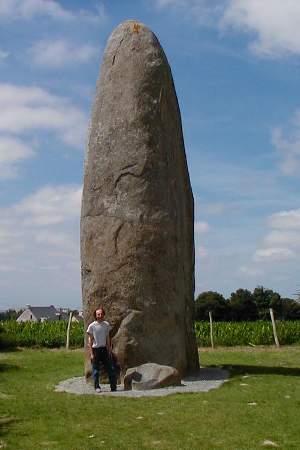
Le Menhir du Champ Dolent
Some standing stones are Christianised. A cross once was carved in the stone or a metal cross was put on top...

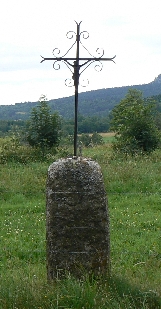
Not all standing stones are real megaliths. Some are natural rock formations, other are more recent.
Stone circles
In many sites the standing stones are set in a circular shape, sometimes surrounded by a ditch. The biggest stone circle is situated in Avebury (G.B.). Stone circles are also called "cromlechs". The term "cromleg" is also used for incomplete circles, elliptic- and rectangular shapes.

Stone circle - Avebury
Dolmen, Passage tomb etc.
The variation in names can be very confusing...
Dolmen strictly seen have only one capstone, also called portal tomb. Possible this kind of monuments never was covered by a mound. Constructions whit several capstones, like "passage tombs", are also often called "dolmen".
The name "dolmen" or "stone table" is formed by the Breton words "dol" (table) and "men" (stone).

Passage tombs or passage graves,
in French allée
couverte,
are names used for tombs consisting a passage made of many side stones
supporting several capstones.
Many tombs have an entrance ending in a chamber, this type is called
chambered
tomb. The chamber can be rectangle or round, sometimes consisting side-chambers.
Many monuments are still covered
by a mound of sand or stones.
When the mound is made of stones the name cairn is
used.
(Example: Cairn de Gavrinis, Morbihan)
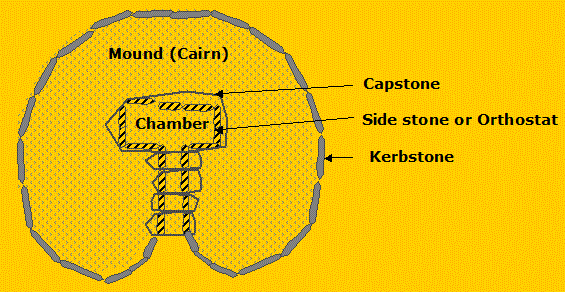
A ring of kerbstones often encircles the mound.
Court tombs are an Irish variant whit an enclosed "court" in front.
Passage tombs covered whit a mound of sand are also called tumulus.
(Example: Tumulus de Kercado, Carnac). This can be confusing; the term
"tumulus" is also used for Bronze Age and Iron Age grave mounds without
stone construction.
Barrow is the English name for a grave
mound of sand, most barrows origin from Bronze Age.
A long barrow is a long grave
mound.
Long barrows are strictly seen no megalithic monuments, they have no stone
construction inside. Many long barrows belong to the oldest monuments.
Hunebedden are a variation on passage tombs existing in the Netherlands and Germany. The entrance is situated on one of the sides, not in front.
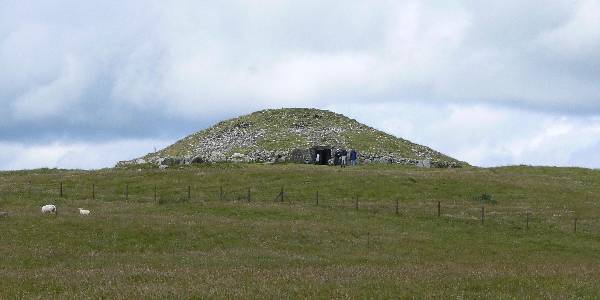
Loughcrew (Cairn-T) - Ireland
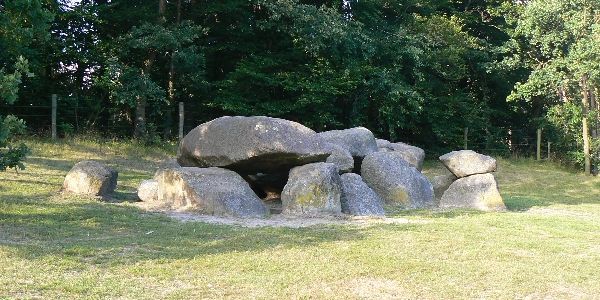
Hunebed D1, Steenbergen (Drenthe, Netherlands)
Henge

"Henge" mains "hanging stone", called after the famous example in Stonehenge (G.B.). The stone construction in Stonehenge is set inside a circular ditch. Other monuments consisting a circular ditch are also called henge, even if hey are stone less. (Example: "Durrington Walls" near Stonehenge.)
'Back to top' - Age (= Next page)